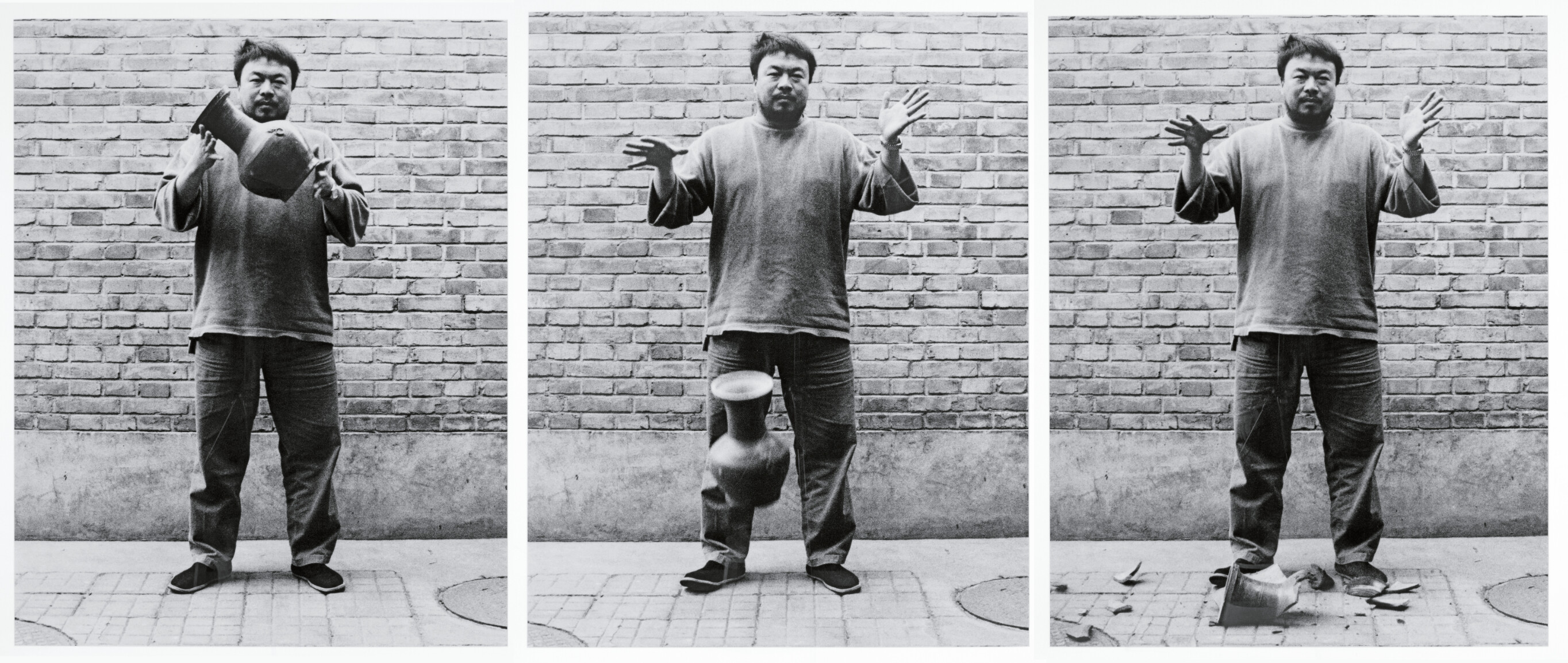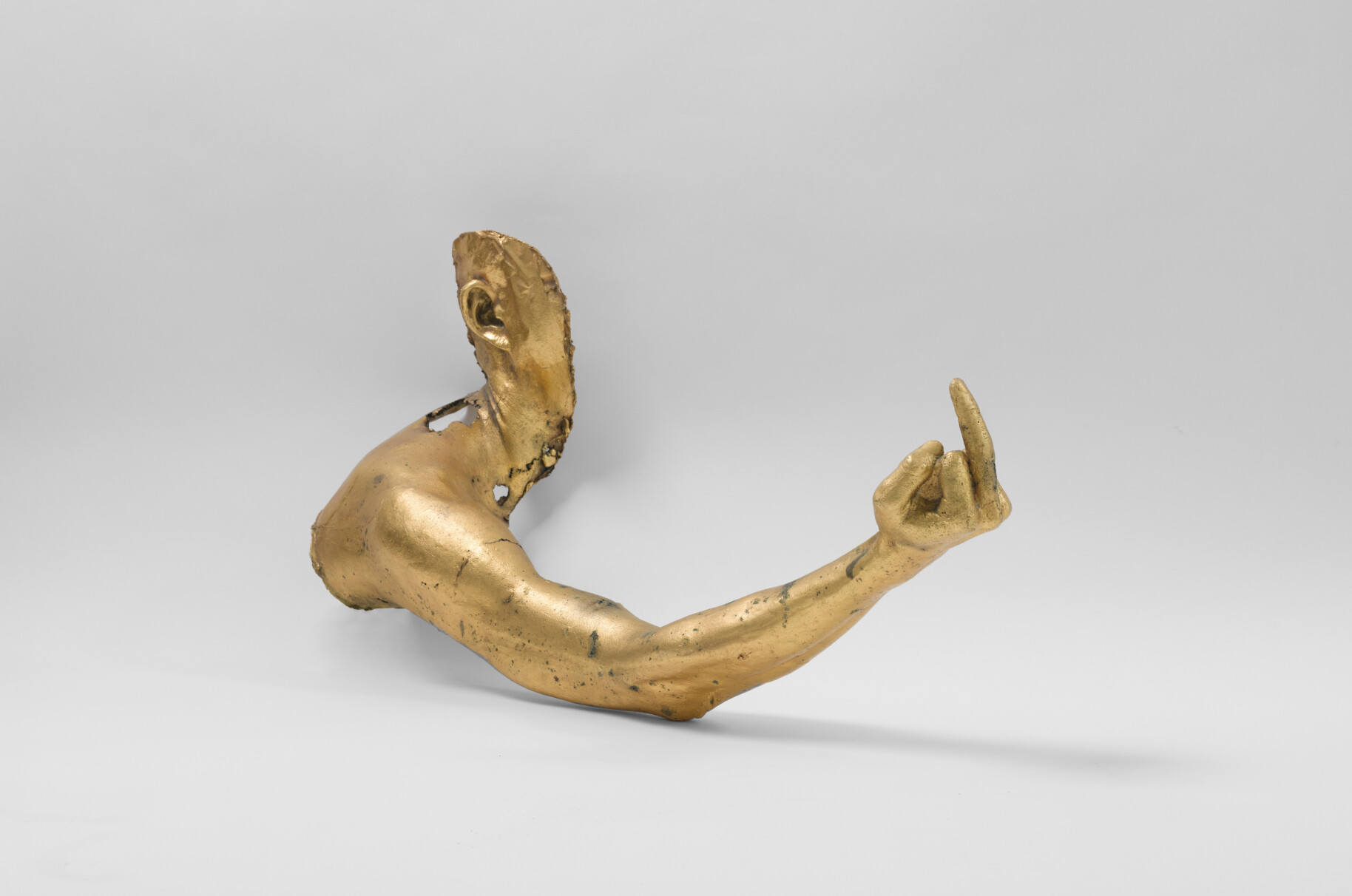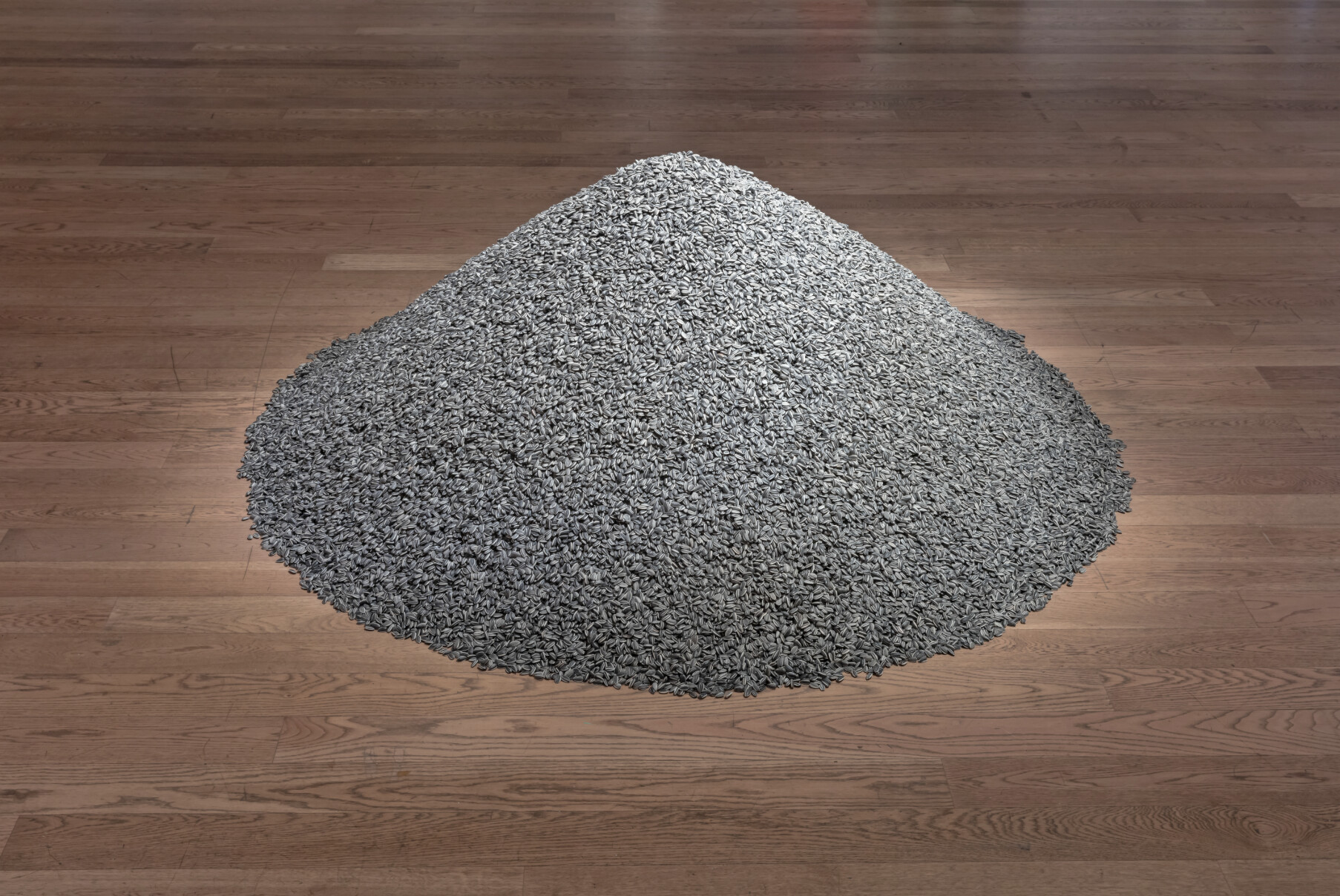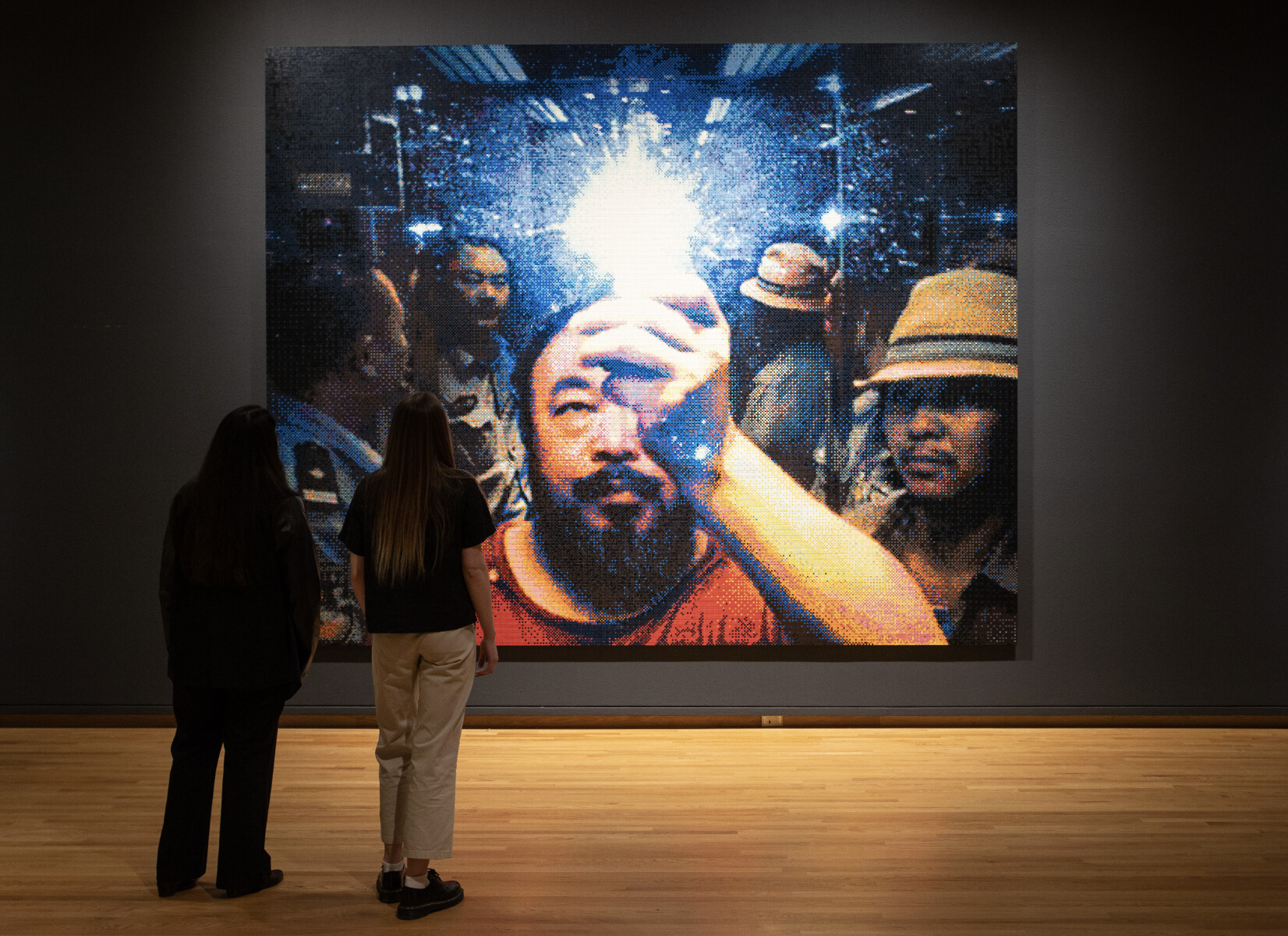Ai Weiwei's Slippery Truths: Home, Exile, and the Fragility of Freedom

As I rise on the escalator to the top floor of the Seattle Art Museum, my breath catches. To the right, glowing in defiant blue neon, four letters spell out "FUCK." The raw power of that profanity illuminating the institutional space feels like permission to be angry, to reject polite discourse when politeness itself becomes complicity.
Reading the wall text, one learns that it’s wordplay. Originally designed for Ai Weiwei’s FAKE Design Studio in Beijing; the word “fake," when pronounced with Mandarin intonation, sounds like the English expletive. It's a multilayered provocation typical of Ai Weiwei’s work.
The gallery is filled with provocations. Two walls are covered in the artist's [middle] Finger wallpaper. Three iterations of Arm with the Finger in Bronze, a sculpture of an arm extended in the gesture of flipping off, are placed on plinths across the room. These defiant middle fingers are echoed in Study of Perspective, a series of photographs made from 1995 to 2011 that depict the artist’s middle finger raised toward sites of power around the world, from Tiananmen Square to the White House.
I find myself immediately drawn toward a bank of black-and-white photographs that show Ai Weiwei dropping a precious antique vase. This iconic triptych, Dropping a Han Dynasty Urn, transfixes me. I reach for one of the audio guides mounted nearby and the entire contraption pulls out of the wall, hanging by a single screw.
I freeze, mortified. Did I just break something at the goddamn Seattle Art Museum? My eyes dart around. Here I am, standing in front of photos documenting the intentional destruction of priceless artifacts, and I've accidentally vandalized the exhibit.
The cosmic joke isn't lost on me. For a split second, I consider letting the earpiece dangle there like my own guerrilla intervention. But my conscience (as a former museum-staffer) kicks in, and I carefully rehang it. Still, I can't help but laugh at myself. Breaking things while looking at Ai breaking things. Maybe I'm more qualified to review this exhibition than I thought.
Ai Weiwei has never been one to let silence win. His art is an act of defiance, a testament to the unresolved questions of history, and an insistence on speaking truth to power. Now, as his 40-year retrospective unfolds at the Seattle Art Museum, the weight of his work feels more urgent than ever.
Ai, Rebel: The Art and Activism of Ai Weiwei is the largest exhibition of the artist’s work in the U.S. and spans 40 years of his work. On view through September 7, the exhibit includes 130 works, from video and custom-made wallpaper to fake antiquities and “paintings” made of LEGO bricks. His work is spilling beyond the walls of SAM’s downtown location: From May 17 through May of 2027, his Circle of Animals/Zodiac Heads (Bronze) will be installed at Olympic Sculpture Park, and the ultra-large-scale LEGO rendition of Monet’s Water Lilies (50 feet wide and made from 650,000 blocks) will be on display at Seattle Asian Art Museum through March of 2026.
This all lands at a moment when global politics are in turmoil, when democracy feels fragile, and when questions of home, exile, and state control are not just theoretical but lived realities for millions.
Ai, Rebel sprawls magnificently across the top floor of the museum, flowing from one space to another in a way that mirrors the interconnectedness of the artist’s ideas and actions as well as his own refusal to be contained. The density prevents viewers from settling in too comfortably and instead creates unexpected sightlines and juxtapositions between works from different periods that continually disrupt and challenge. This spatial arrangement itself becomes part of the message: resistance cannot be boxed in.

At one moment during a press preview tour led by the exhibit’s curator, Foong Ping, I find myself standing before a crescent of twelve golden zodiac animal heads, trying to follow them in sequence. Rat, ox, tiger...wait, where's the rabbit? The arrangement makes no sense. Thinking I've misunderstood, I catch Ping smiling at my confusion.
"They're not in order," she admits with a conspiratorial gleam. "There are games throughout the exhibition, little Easter eggs and disruptions. Ai never gives you what you expect."
Such playfulness is traced back to Ai's earliest works, which were heavily influenced by Marcel Duchamp, something the exhibition chronicles as it touches on the artist’s formative years spent in New York City, where the lessons of Dada and pop art were being absorbed and assimilated into Ai’s blossoming style of cultural critique. Four decades later, a life’s worth of work is all about upending expectations. Even the museum-going experience becomes a playground for mischief.
The visitor of Ai, Rebel could spend hours getting lost in the hunt for curatorial tricks, wondering if certain pieces are deliberately hung crookedly, or if some labels contain misinformation. The uncertainty is delightful.
The gold busts from the 2010 series Circle of Animals/Zodiac Heads are rife with implications about cultural theft and repatriation. But Ai's reproductions are more than a simple gesture of patriotic reclamation. Like many of his replicas and fakes, they offer a head-spinning commentary on authenticity, cultural ownership, and the manipulation of history for political purposes. As though to ask: Who owns cultural heritage? The nation state? Museums? The marketplace? All the while, Ai winkingly implicates himself in the very system of cultural production and commodification he critiques.
+++
Ai Weiwei's personal history is inseparable from his artistic practice. Born in 1957, he is the son of Ai Qing, a revered Chinese poet who was exiled during Mao's Anti-Rightist Campaign. Forced into hard labor in the remote northwestern province of Xinjiang, he spent years cleaning public toilets. Ai was a child at that time; his earliest memories of home were of a place underground—literally and figuratively—that his family had crammed into, little more than a hole dug into the earth.
Ai’s meditations on home, both as a physical space and an idea, is a thread that interweaves through the exhibit, found in such works as his 2010 Sunflower Seeds, a masterful trompe-l'œil (French for "deceive the eye") that tricks viewers into seeing ordinary seeds when none exist. Only on closer inspection is the truth revealed: Each porcelain seed has been individually handcrafted and painted by Chinese artisans. Each is unique yet visually indistinguishable in the group—a nod to China's complex relationship with mass production and individualism. For Ai, the seeds also evoke a particular sense of nostalgia that belonged to his father's generation, for whom sunflower seeds were a small comfort in times of hardship. They represented a subtle act of resistance: the simple pleasure of cracking open a seed, consuming it, and discarding the shell. A tiny rebellion enacted millions of times daily across China.

As the exhibition unfolds, some bodies of work take a more overt turn toward confronting disaster and the governments responsible for it. In a section titled "Watching Ai Watching Power," the installation Snake Ceiling winds overhead, its serpentine shape constructed from hundreds of children’s backpacks—objects pulled from the rubble of schools destroyed in the 2008 Sichuan earthquake. In the same room, a wall is filled with a list of tiny printed names, thousands long—Names of the Student Earthquake Victims Found by the Citizens' Investigation.
Like the porcelain sunflower seeds, Ai’s LEGO pieces take on different meanings when viewed up close or from a distance. One haunting work depicts the moment of the artist’s 2011 arrest at Beijing Airport. This moment is crystalized in time in a selfie he managed to snap while being hauled away in an elevator, surrounded by guards. The bright toy bricks create a disarming moment of joy that both softens and amplifies the gravity of state repression.
Ai Weiwei now lives in Portugal, having left China in 2015 after being detained, harassed, and surveilled for several years. The work titled 81 consists of a to-scale replica of the padded jail cell where Ai was held in 2011—without any formal charges—for 81 days. Viewers can enter and walk around. The sparse furnishings, stains, and walls wrapped in polyethylene foam are chilling. The structure's exterior remains featureless because Ai was brought to the site in a hood and never saw it. Cameras inside the cell create the uncomfortable sense that the museum visitor, too, may be monitored in real time. Or are the cameras even real?
Further along in the exhibit is The First Page of the Mueller Report, Submitted to Attorney General William Barr by Robert Mueller on March 22, 2019, another LEGO reconstruction, this time of the heavily redacted Mueller Report that investigated Russian interference in the 2016 U.S. election. The wall-sized piece, filled with large black bars and obscured text, suggests that authoritarianism is not such a distant reality in established democracies; the comfortable distance between "us" and "them" has collapsed.

+++
Assembling this retrospective in just 13 months—a staggeringly short amount of time for an exhibition of this scale—Foong Ping, SAM’s Foster Foundation Curator of Chinese Art, has created not just a survey of Ai’s career but a conversation between his work and the present moment. It’s worth noting that SAM moved quickly to organize the show shortly after a London exhibition at the Lisson Gallery was “effectively cancelled” after the Ai posted comments on social media referencing the Israel-Hamas war. One can’t help but appreciate the audacity of Ping and the museum in seizing an opportunity to welcome the maker of “trouble,” when many in the art world are unwilling.
Her approach is subversive. With plans to place Ai Weiwei’s works across all three of SAM's venues, she creates productive tension between container and contained. There are no content warnings, no apologetic explanations for the profanity or provocations. Instead, Ping has arranged the exhibition as a series of encounters that gradually reveal the interconnections between Ai's projects and preoccupations.
Ping’s curatorial vision extended to her moderation of a Town Hall event with Ai a few days before the exhibition opened, where the artist made himself available to the community. What’s most striking about Ai in person is how approachable he seems: wearing a simple nondescript shirt, making jokes with kind eyes, and looking slightly bored by all the fuss.
When asked about the title Ai, Rebel, he responds with characteristic subversion: "I don't like that word so much, you know. I'm a rebel to the meaning of rebel." The audience laughs, but Ping nods knowingly. This resistance to categorization is precisely what she's captured in her curatorial approach.
Ai’s jokes didn’t hinder a stream of questions from an audience that collectively seems to be holding their breath, awaiting a directive from the seasoned dissident. When asked what socioeconomic system he believes is best for humanity, he responds with unexpected directness. "I think what happens in the West, or in general terms, ‘the West,’ could be much more harmful to humanity than China. China, compared to what happens here, is nothing. We are facing a real danger to humanity." The audience shifts uncomfortably.
Perhaps because the hard truth resonates on a visceral level. I recognize the dissonance between my nation's proclaimed values and my lived experience. The ways in which "home" has often been made inhospitable through systemic inequities and outright hostility.
Ai Weiwei makes us uncomfortable because he points out that to be passive is to be complicit. Every time we trade freedom for security, every time we look away from injustice because confronting it is exhausting, we are participants in our own systems of oppression. But we are also powerful. We all have the capacity to rebel. Maybe not by dropping priceless ancient vases or flipping off famous landmarks. But in our own ways, through our own means, according to our own circumstances. The form our rebellion takes is up to us.
In his own words, "Liberty is about our right to question everything." Seattle Art Museum has given us a rare opportunity to do just that: To question, to consider, and, perhaps, to rebel.
For those of us who have felt the contradiction between our nation's promises and its practices, walking among Ai's creations feels like finding unexpected kinship across vast differences of history and culture. A shared understanding that home is something we fight for, even when, especially when, it refuses to welcome us as we are.
The audio guide that came loose in my hand seems, in retrospect, almost intentional. A subtle reminder that even the most carefully constructed systems can come undone with the gentlest pull.
Ai Weiwei is on view at Seattle Art Museum (THROUGH SEPT. 7), Seattle Asian Art Museum (THROUGH MARCH 15, 2026), and Olympic Sculpture Park (MAY 2025–MAY 2027).